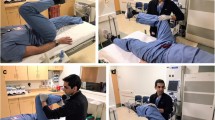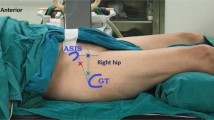Abstract
Purpose
The purpose of this paper was to evaluate the response to intra-articular hip injections with and without concurrent gadolinium administration. Our secondary outcome was to compare post-operative outcomes between patients with an initial false-negative gadolinium-containing injection and a matched control group.
Methods
Patients receiving a series of two hip diagnostic intra-articular injections (DIAI), the first with gadolinium for concurrent MRA and the second without gadolinium, were retrospectively identified. Pain response to DIAI, injectate volume, local anesthetic volume, inclusion of corticosteroids, and method of injection were compared between injections. False-negative injection was defined as < 50% pain relief with concurrent gadolinium, but ≥ 50% pain relief with subsequent anesthetic injection without gadolinium. False-negative injections in patients that ultimately underwent primary hip arthroscopy were identified from this cohort and matched in a 3:1 ratio to a control cohort to compare short-term post-operative single assessment numerical evaluation (SANE) outcomes.
Results
Forty-three patients underwent a series of anesthetic injections with and without gadolinium and met inclusion and exclusion criteria. Pain response was significantly different in injections performed with and without gadolinium (18% vs. 81%; p < 0.001). There were significant differences in total injectate volume, local anesthetic volume, corticosteroid use, and method of injection between injections, but these variables were not correlated with pain response. Fifteen patients with false-negative responses to injection underwent primary hip arthroscopy and were matched in a 3:1 ratio to a control cohort. There was no difference in short-term post-operative SANE scores between the gadolinium-sensitive and control groups (81.6 vs. 80.0, n.s.).
Conclusion
Concurrent administration of intra-articular gadolinium with DIAI may result in a false-negative response to anesthetic. Additionally, in patients with initial false-negative DIAI with gadolinium, short-term post-operative outcomes after hip arthroscopy are similar to a matched cohort.
Level of Evidence
Level III.


Similar content being viewed by others
References
Berthelot JM, Brulefert K, Arnolfo P, Le Goff B, Darrieutort-Laffite C (2022) Update on contribution of hip labral tears to hip pain: a narrative review. Joint Bone Spine 90:105465
Botser I, Safran MR (2013) MR imaging of the hip: pathologies and morphologies of the hip joint, what the surgeon wants to know. Magn Reson Imaging Clin N Am 21:169–182
Bruno D, Veale BL (2021) Effects of gadolinium depositions in vivo. Radiol Technol 93:46–54
Burke LM, Ramalho M, AlObaidy M, Chang E, Jay M, Semelka RC (2016) Self-reported gadolinium toxicity: a survey of patients with chronic symptoms. Magn Reson Imaging 34:1078–1080
Byrd JW, Jones KS (2004) Diagnostic accuracy of clinical assessment, magnetic resonance imaging, magnetic resonance arthrography, and intra-articular injection in hip arthroscopy patients. Am J Sports Med 32:1668–1674
Byrd JW, Jones KS (2001) Hip arthroscopy in athletes. Clin Sports Med 20:749–761
Deshmukh AJ, Thakur RR, Goyal A, Klein DA, Ranawat AS, Rodriguez JA (2010) Accuracy of diagnostic injection in differentiating source of atypical hip pain. J Arthroplasty 25:129–133
Elawad A, Shah A, Davies M, Botchu R (2021) The use of gadolinium in musculoskeletal MRI-time to rethink? Indian J Radiol Imaging 31:635–643
Gao G, Fu Q, Wu R, Liu R, Cui L, Xu Y (2021) Ultrasound and ultrasound-guided hip injection have high accuracy in the diagnosis of femoroacetabular impingement with atypical symptoms. Arthroscopy 37:128–135
Giaconi JC, Link TM, Vail TP, Fisher Z, Hong R, Singh R et al (2011) Morbidity of direct MR arthrography. AJR Am J Roentgenol 196:868–874
Hajek PC, Sartoris DJ, Gylys-Morin V, Haghighi P, Engel A, Kramer F et al (1990) The effect of intra-articular gadolinium-DTPA on synovial membrane and cartilage. Invest Radiol 25:179–183
Haws BE, Condidorio CG, Adler KL, Giordano BD (2022) Diagnostic intra-articular injection with provocative functional testing predicts patient-reported outcomes following hip arthroscopy: a prospective investigation. J Hip Preserv Surg 9:158–164
He ZY, Liu ZM, Bi GJ, Zhang XL, Wang JQ, Jiang L et al (2022) A comparison between ultrasound-guided AIIS injection and radiography in the diagnosis of subspine impingement in patients with FAI. BMC Musculoskelet Disord 23:1082
Kalisvaart MM, Safran MR (2015) Microinstability of the hip-it does exist: etiology, diagnosis and treatment. J Hip Preserv Surg 2:123–135
Kuhlman GS, Domb BG (2009) Hip impingement: identifying and treating a common cause of hip pain. Am Fam Physician 80:1429–1434
Lattanzio SM (2019) The gadolinium hypothesis for fibromyalgia and unexplained widespread chronic pain. Med Hypotheses 129:109240
Lau BC, Scribani M, Lassiter T, Wittstein J (2019) Correlation of single assessment numerical evaluation score for sport and activities of daily living to modified harris hip score and hip outcome score in patients undergoing arthroscopic hip surgery. Am J Sports Med 47:2646–2650
Lee GY, Kim S, Ha YC (2023) Hip magnetic resonance arthrography using normal saline is less accurate than using a gadolinium-based contrast agent. Arthroscopy 39:990–997
Li S, Li C, Wang H, Luo Y, Li H, Zhang M (2021) Utility of ultrasound-guided anesthetic intra-articular injection to estimate the outcome of hip arthroscopy in patients with femoroacetabular impingement syndrome. Orthop Surg 13:1810–1817
Lynch TS, Steinhaus ME, Popkin CA, Ahmad CS, Rosneck J (2016) Outcomes After Diagnostic Hip Injection. Arthroscopy 32:1702–1711
Malhotra G, Hansford BG, Felcher C, Wuerfel KA, Yablon CM (2022) Fluoroscopic-guided procedures of the lower extremity. Skeletal Radiol. https://doi.org/10.1007/s00256-022-04139-w1-20
Martin RL, Irrgang JJ, Sekiya JK (2008) The diagnostic accuracy of a clinical examination in determining intra-articular hip pain for potential hip arthroscopy candidates. Arthroscopy 24:1013–1018
Mujahed T, Hassebrock JD, Makovicka JL, Pollock JR, Wilcox JG, Patel KA et al (2021) Preoperative intra-articular steroid injections as predictors of hip arthroscopy: 2-year outcomes. Orthop J Sports Med 9:23259671211053816
Register B, Pennock AT, Ho CP, Strickland CD, Lawand A, Philippon MJ (2012) Prevalence of abnormal hip findings in asymptomatic participants: a prospective, blinded study. Am J Sports Med 40:2720–2724
Safran MR (2010) The acetabular labrum: anatomic and functional characteristics and rationale for surgical intervention. J Am Acad Orthop Surg 18:338–345
Saupe N, Zanetti M, Pfirrmann CW, Wels T, Schwenke C, Hodler J (2009) Pain and other side effects after MR arthrography: prospective evaluation in 1085 patients. Radiology 250:830–838
Schmitz MR, Campbell SE, Fajardo RS, Kadrmas WR (2012) Identification of acetabular labral pathological changes in asymptomatic volunteers using optimized, noncontrast 1.5-T magnetic resonance imaging. Am J Sports Med 40:1337–1341
Vap AR (2023) Editorial commentary: gadolinium intra-articular contrast magnetic resonance imaging is not required for every patient undergoing hip arthroscopy, but contrast magnetic resonance imaging plus computed tomography with 3-dimensional reconstruction are essential for patients requiring revision. Arthroscopy 39:998–999
Zhang P, Li C, Wang W, Zhang B, Miao W, Liu Y (2022) 3.0 T MRI is more recommended to detect acetabular labral tears than MR arthrography: an updated meta-analysis of diagnostic accuracy. J Orthop Surg Res 17:126
Zimmerer A, Schneider MM, Tramountanis K, Janz V, Miehlke W, Wassilew GI et al (2022) Assessment of acetabular chondral damage and labral pathologies via direct MR arthrography: specialization matters. Arch Orthop Trauma Surg 142:1563–1569
Funding
There is no funding source.
Author information
Authors and Affiliations
Corresponding author
Ethics declarations
Conflict of interest
WMP, CJ, and NS have no disclosures to report. DMC reports the following disclosure: Arthroscopy Journal, Editorial Board. MRS reports the following disclosures: American Journal of Sports Medicine: Editorial or Governing Board, Biomimedica: stock or stock options and unpaid consultant; DJ Orthopedics: IP royalties; International Society of Arthroscopy, Knee Surgery, and Orthopaedic Sports Medicine: Board or Committee Member; JISAKOS: Editorial or Governing Board; Journal of Hip Preservation Surgery: Editorial or Governing Board; Medacta: paid consultant and paid presenter or speaker; Saunders/Mosby-Elsevier: publishing royalties, financial or material support; Smith & Nephew: IP royalties; paid presenter or speaker and research support; Stryker: IP royalties; Subchondral Solutions: stock or stock options and unpaid consultant; Wolters Kluwer Health—Lippincott Williams & Wilkins: publishing royalties, financial or material support.
Ethical approval
IRB Information: Protocol #49494 was approved by the Stanford University Institutional Review Board on 8/16/20.
Additional information
Publisher's Note
Springer Nature remains neutral with regard to jurisdictional claims in published maps and institutional affiliations.
Rights and permissions
Springer Nature or its licensor (e.g. a society or other partner) holds exclusive rights to this article under a publishing agreement with the author(s) or other rightsholder(s); author self-archiving of the accepted manuscript version of this article is solely governed by the terms of such publishing agreement and applicable law.
About this article
Cite this article
Pullen, W.M., Curtis, D.M., Jamero, C. et al. Gadolinium injected concurrently with anesthetic can result in false-negative diagnostic intra-articular hip injections. Knee Surg Sports Traumatol Arthrosc 31, 2746–2753 (2023). https://doi.org/10.1007/s00167-023-07392-1
Received:
Accepted:
Published:
Issue Date:
DOI: https://doi.org/10.1007/s00167-023-07392-1




